I. CONCEPTION AND DESIGN:
Mindful Ocean is a project that aims to explore the potential benefits of combining mindfulness practices with the calming environment of the ocean. Inspired by scuba diving in Bali and Susan Beniston’s art project on breath-taking time, the project’s centerpiece combines an interactive helmet and the textile screen. By incorporating tactile, visual, and audio feedback loops, Mindful Ocean encourages participants to incorporate mindfulness practices into their daily routines. To implement this purpose, the practice of breathing is stimulated by the classic mini-game Flappy Bird. Through this project, we also hope to promote awareness of ocean protection and appreciation of nature – humans are just part of the great nature – extending beyond the installation and into people’s daily lives.
Interactivity
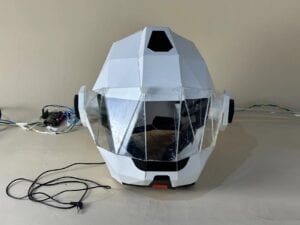
1. Helmet: The central element of Mindful Ocean is a helmet constructed from cardboard and laser-cut acrylic board. Upon wearing the helmet, users immediately immerse themselves in a genuine undersea environment, as they are enveloped and embraced by its design. The helmet fits snugly, exerting slight pressure around the neck and head, enhancing the sensation of being submerged. While the transparent acrylic face mask allows for visibility, it also creates an airtight space, engendering a sense of confinement. Within the helmet, users are provided with embedded headphones that deliver impeccable sound feedback, featuring ambient undersea noises and whale communication. Overall, the helmet serves as the primary interface for interaction between the user and the installation.
2. Breathing system (regulator): Enhancing the level of interactivity within Mindful Ocean is an extension of the helmet known as the breathing system, which closely emulates a scuba diving regulator. This system offers participants a more intimate and immersive experience.
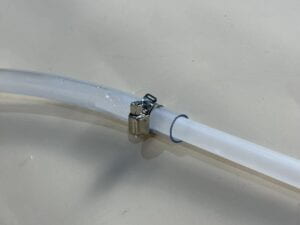
It consists of a flexible hose approximately 1 meter long and interchangeable suction straws for breathing in and out. At the opposite end of the hose, there is a steam sensor to convert the intensity of the breaths to the humidity value of the steam in the tube. Unlike traditional modes of interaction such as touch or speech, the breathing system encourages participants to hold the hose and breathe through it, fostering a deeper connection.
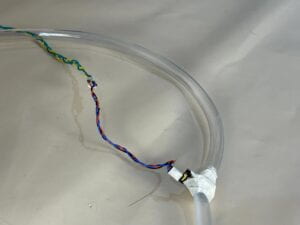
Therefore, regression on this simplest action allows participants to experience physical and mental relaxation and meditation. By incorporating the regulator system, the installation allows for heightened engagement between the user and the environment.
3. Swimming and the mini-game: Our vision for Mindful Ocean extends beyond a unidirectional experience that merely accepts user input without providing output or feedback. With this in mind, we have devised an additional mechanism that adds an element of fun while visualizing the user’s input, specifically their breathing. To achieve this, we have created a game inspired by the “Flappy Bird” structure.
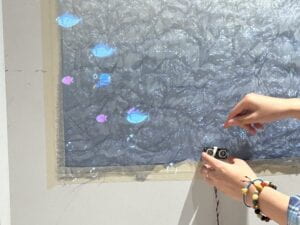
In this game, the participant aims to keep the diver afloat in the water while avoiding contact with the shark. To accomplish this, the participant must perform breaststrokes to make the diver ascend and maintain a steady breathing rhythm to sustain the life bar. This introduces a more intricate interactive loop encompassing the helmet, the regulator system, and the mini-game, which is projected onto a background composed of shimmering fabrics.
Lessons from the User Testing Session
During the User Testing session on Friday, May 5, we received many invaluable suggestions, practical insights, and inspiring feedback from students, fellows, and faculty members. These contributions have played an important role in shaping our project as we incorporated numerous modifications and revisions based on the received feedback. We extend our heartfelt gratitude to all those who participated in testing our projects and provided their invaluable feedback once again!
1. Enhancing the visualization of breathing: During the user testing session, Professor Eric Parren expressed his enthusiasm for the concept of integrating breathing into the game experience. He suggested incorporating a life bar would further engage the participants and create a more immersive atmosphere. Before the testing, we had a similar idea but could not implement it due to time constraints. Our initial plan was to adjust the brightness of the background based on the intensity of breathing. However, after careful deliberation and discussions, we agreed that implementing a vibrant “life bar” in a striking color like red would more effectively compel users to focus on their breathing.
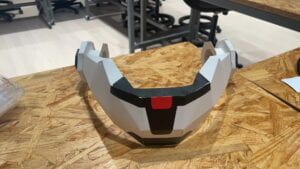 2. Helmet Adjustment: During the user testing phase, we encountered an unexpected issue related to the helmet size, particularly for individuals with larger heads. We did not expect this during our own testing, as both Vickie and I have relatively smaller heads being females. To address this problem, we have devised a two-fold solution. Firstly, we have separated the wearable mask from the main part of the helmet, allowing users to put on the helmet and the mask separately. By removing the mask, we have significantly improved the ease of fitting into the helmet. Secondly, we made adjustments by cutting the back of the helmet for more flexibility, enabling users to insert their heads comfortably. These modifications aim to accommodate individuals with varying head sizes and ensure a more inclusive and comfortable experience.
2. Helmet Adjustment: During the user testing phase, we encountered an unexpected issue related to the helmet size, particularly for individuals with larger heads. We did not expect this during our own testing, as both Vickie and I have relatively smaller heads being females. To address this problem, we have devised a two-fold solution. Firstly, we have separated the wearable mask from the main part of the helmet, allowing users to put on the helmet and the mask separately. By removing the mask, we have significantly improved the ease of fitting into the helmet. Secondly, we made adjustments by cutting the back of the helmet for more flexibility, enabling users to insert their heads comfortably. These modifications aim to accommodate individuals with varying head sizes and ensure a more inclusive and comfortable experience.
3. Game: From a technical standpoint, Professor Gottfried Haider suggested modification to the game mechanics that we position all the obstacles at the bottom of the sea. This would only involve jumping over these obstacles, similar to the dinosaur game found on Google. While this suggestion was very thoughtful, and even though we had the annoying lagging with Processing during user testing, we ultimately chose not to implement it. Our decision was driven by our desire to optimize the diving experience for users, creating an environment where gravity has a diminished presence and allowing them to move both upwards and downwards freely. By retaining the original game mechanism, we could reduce stress levels and align more closely with our overall objective of promoting mindful breathing during the gameplay.